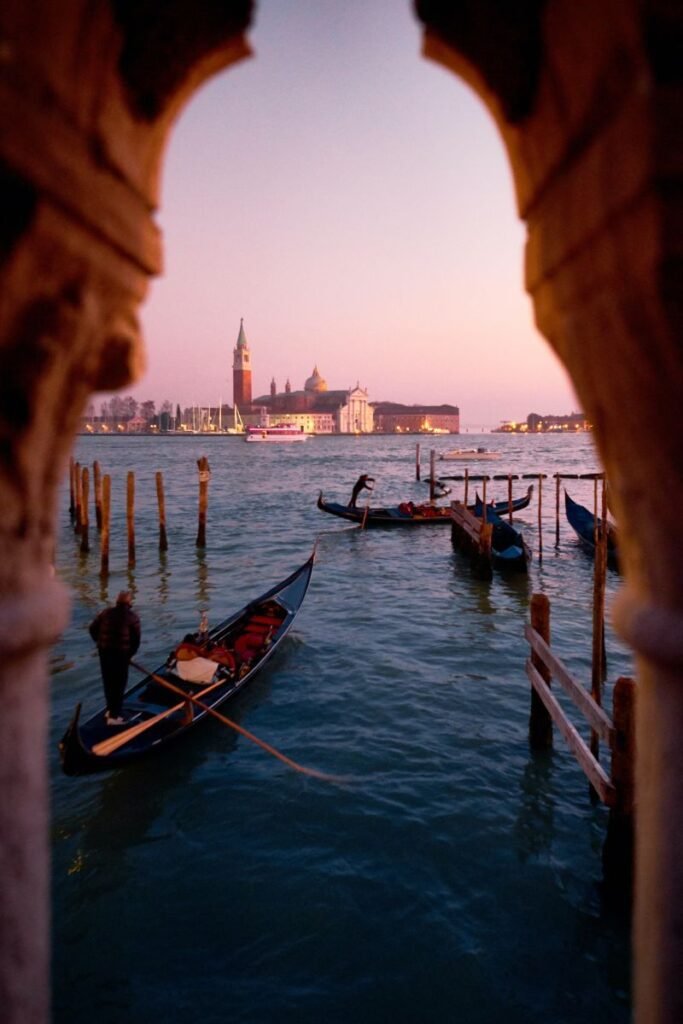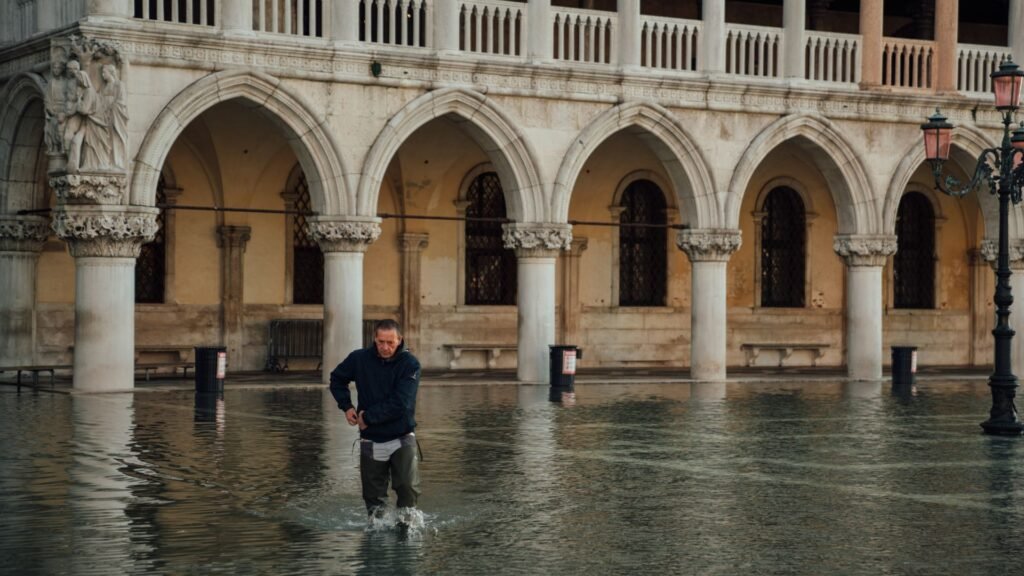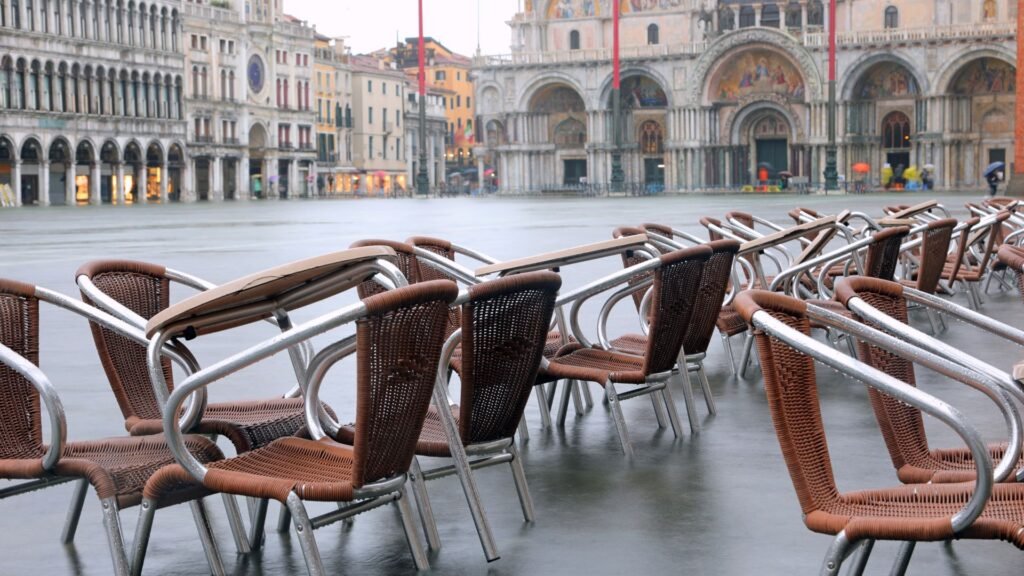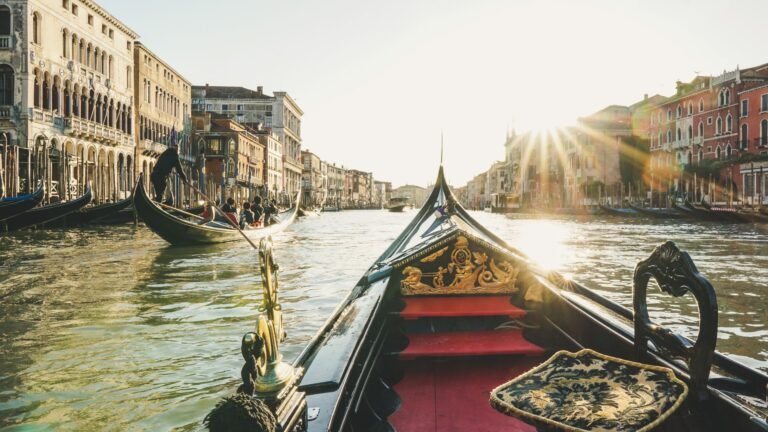Built on 117 small islands in northeastern Italy, Venice’s architectural splendor and rich cultural heritage are both its allure and its Achilles heel.
The city’s vulnerability to sinking stems from a mix of natural and human factors — subsidence due to groundwater extraction and geological processes, coupled with rising sea levels caused by climate change. These issues not only threaten Venice’s structures but also erode its architectural legacy through damaging salt deposits left behind by floods.
Efforts to combat these challenges have been underway for years, but finding lasting solutions has been difficult. As the city’s fate hangs in the balance, the effectiveness of the proposed measures has yet to be proven, leaving many to wonder, “Could Venice actually sink in my lifetime?”
It’s not likely, but it could happen, as you’re about to learn as we examine the causes and consequences surrounding Venice’s sinking and flooding issues, as well as potential solutions that experts and engineers are investigating to protect this living testament to human ingenuity.
“The quality of Venice that accomplishes what religion so often cannot is that Venice has made peace with the waters.”
MARK HELPRIN
A Historical Perspective on Venice’s Floods
Flooding in Venice actually isn’t anything new. Its location within the Venetian Lagoon makes it susceptible to rising tides and storm surges and has for centuries.
The shaky foundation of the city doesn’t help, either. Settlers in the 5th century laid the foundation by driving wooden piles into the marshy ground, but recent decades have seen a troubling increase in both flood frequency and intensity.
Climate change and other factors led to the massive floods we saw in November 2019, when the water levels reached their highest levels in over 50 years (unfortunately, this record was surpassed in November 2022).
Over the centuries, Venice has employed various measures to mitigate flooding, like constructing elevated walkways called altane and developing an intricate system of canals and drains.
The Venetian acqua alta warning system also helps residents prepare for high tides. Additionally, projects like MOSE (Modulo Sperimentale Elettromeccanico) are underway to protect the city from future flooding through movable barriers at the lagoon’s entrances.
Understanding Acqua Alta
To understand the history of flooding in Venice, you need to understand acqua alta — high water events that lead to flooding. While not new, its frequency and intensity have increased in recent years due to climate change and rising sea levels.
Normal tides in Venice, typically below 80 cm, don’t affect the city. However, with water levels surpassing this height around 50 times per year, flooding impacts about 0.1% of public itineraries. For reference, acqua alta is marked by tides ranging from 80 to 110 cm, while exceptional tides exceed 140 cm, emphasizing the need for vigilance and adaptive strategies.
While this might sound like a lot of scientific jargon to most, a thorough understanding of acqua alta is vital for both Venetians and the global community to reduce its impact and preserve Venice’s cultural and historical treasures.
Also Read: What is the Capital of Italy?

With each passing year, the threat to the city’s buildings, artifacts, and residents grows more pressing. To highlight how important the issue is, here are three intriguing facts about Venice’s ongoing struggle with water:
- Venice is sinking at a rate of 1 to 2 millimeters per year: This gradual descent is due to both natural and human factors, such as subsidence caused by groundwater extraction and geological processes, as well as the rising sea levels resulting from climate change.
- The highest recorded acqua alta reached 204 cm in November 2022: The previous recorded record was 194 cm (76 inches) in 1966, and of the top ten highest acqua altas recorded in history, four have occurred in the past five years.
- The MOSE project aims to protect Venice from flooding: In development since 1987, this ambitious undertaking involves constructing movable barriers at three inlets to the Venetian Lagoon. When completed, MOSE will help shield the city from high tides and storm surges, preserving its cultural heritage and unique charm for future generations.
Reasons Behind Venice’s Sinking
As mentioned, Venice’s sinking is caused by two primary factors: ground subsidence and rising sea levels.

Ground subsidence occurs due to the extraction of groundwater and the weight of the city’s infrastructure on its weak foundation. This is worsened by the sinking of the underlying clay and soft soils. This is due to the fact that Venice was built on low-lying salt marsh islands.
In addition, rising sea levels contribute to Venice’s problem. Climate change and the melting of ice caps lead to an increase in global sea levels. As a result, the lagoon on which Venice is built experiences higher tides and more frequent flooding, which further accelerates the sinking process.
It might seem like a non-issue, an old wive’s tale we’ve heard our entire lives. However, there’s no denying the fact that Venice is slowly sinking, and humans are contributing to and speeding up that process.
Annual Sinking Rate of Venice
- According to research, Venice experiences an annual sinking rate of around 1 to 2 millimeters per year. Although this may appear insignificant, the long-term cumulative impact can have severe consequences for the city and its residents.
- The slow subsidence of the ground on which Venice stands has been an ongoing process for centuries, causing concern for the city’s stability and infrastructure.
- As Venice continues to sink, it becomes more vulnerable to high tides and flooding. That’s why it’s so crucial for authorities and scientists to monitor and address this issue to ensure the preservation and sustainability of this iconic city.
Climate Change’s Impact on Venice’s Sinking & Flooding

In response to the 2019 floods, Venice’s Mayor Luigi Brugnaro said, “These are the effects of climate change. The costs will be high.”
While this is a global problem, scientists predict that by the end of the century, sea levels could rise by a staggering 120 centimeters (47 inches), and a UNESCO report (from 2011 that would likely look much direr now) predicted that if the Mediterranean Sea swells by 5 feet (1.524 meters), Venetians may confront flooding twice daily.
However, it is important to note that flooding in Venice isn’t necessarily new — we can’t blame modern-day structural damage and everything else on climate change and water management. As the Royal Museums Greenwich reports, city records show there have been 324 very intense high-water events since 1872. However, climate change has made the issue worse.
Shaul Bassi, professor of English literature at Ca’ Foscari University of Venice, told the museum, “For many years, Venetians experienced the flooding as simply a nuisance…Then, of course, things became more serious. Now I think we need to fully understand that flooding is not just at a local level. Venice is at the forefront of the battle against climate change.”
The Financial Impact of Venice’s Floods

As you might imagine, in a city with such storied monuments as St. Mark’s Basilica and Doge’s Palace, even the slightest damage to the city’s priceless art, architecture, and cultural heritage imposes a heavy burden on the city’s economy.
The constant exposure to water and salt threatens the structural integrity of buildings and monuments, requiring costly restoration and preservation efforts. The 2019 floods alone cost $1 billion in damages to homes and monuments.
In addition, local businesses, particularly those in the hospitality and retail sectors, face significant losses due to forced closures during floods and the subsequent cleanup efforts. Namely, if intense flooding continues, tourists might be deterred from planning trips during certain periods for fear of disruptions to their travel plans.
Solutions to Protect Venice From Sinking
In the quest to shield Venice from the relentless onslaught of floods, one remarkable initiative, the MOSE project (Modulo Sperimentale Elettromeccanico), involves constructing mobile barriers that rise to defend the city from surging tides.
The barriers spring into action during exceptional tide events, barring water from entering the lagoon and safeguarding Venice’s architectural marvels. However, some worry about the potential impact on the delicate lagoon ecosystem.
Beyond the MOSE project, Venice is exploring other protective measures. Sustainable urban planning offers one approach, managing growth and development to reduce the city’s vulnerability to floods.
Upgrading infrastructure—elevating buildings and walkways, reinforcing foundations, and improving drainage systems—also plays a vital role in fortifying the city against natural disasters.
The Bottom Line: Addressing Venice’s unique challenges calls for collaboration. By embracing unique strategies, the city can work to counteract the effects of flooding and focus on long-term sustainability.
Predictions: When Will Venice Sink?
Various predictions have been made over the years, with some pessimistic studies claiming that Venice could sink completely by the end of the century.
However, more recent forecasts suggest that a combination of new innovative measures, such as the MOSE retractable gates system, and effective policies to address climate change could give Venice the chance to thrive for longer.
Nevertheless, the window of opportunity is narrow, and we must act now to secure Venice’s future and preserve its unique cultural and natural heritage for generations to come. Because…what a shame it would be to lose such a historical treasure to the sea.
Frequently Asked Questions About Venice Sinking
What’s causing Venice to sink?
Venice is sinking due to a combination of factors, including the extraction of groundwater, the natural subsidence of the land, and rising sea levels caused by climate change.
What has Venice done to stop sinking?
To combat sinking, Venice has implemented projects like MOSE (Modulo Sperimentale Elettromeccanico), a system of barriers designed to protect the city from high tides, and has reduced groundwater extraction.
When was Venice built on water?
Venice was built around the 5th century AD as people sought refuge from barbarian invasions on the marshy islands of the Venetian Lagoon.
How much has Venice sunk?
Venice has sunk approximately 23 centimeters in the last 100 years and up to 150 centimeters since the city was first founded thousands of years ago.


